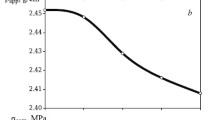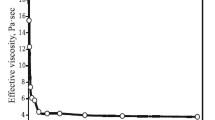The main rheological and processing properties of individual and mixed binders based on SiC and Si are studied. Phase and chemical compositions, main physicomechanical characteristics, and microstructures of samples after annealing in N2 are investigated.
Similar content being viewed by others
Explore related subjects
Discover the latest articles, news and stories from top researchers in related subjects.Avoid common mistakes on your manuscript.
Ceramics based on silicon are widely used in various technology sectors owing to their specific properties [1]. Silicon nitride Si3N4 is a unique compound that was first synthesized by Balmen in 1844 upon heating elemental Si in N2 released during decomposition of potassium cyanide. Si3N4 that was first synthesized in this manner together with silicon carbide, among others, are currently the leading refractories. The usual powder technology techniques are used to produce Si3N4 powders, e.g., various direct syntheses, carbothermal reduction, gas-phase synthesis and decomposition, and mechanical milling as an additional treatment [2]. Si3N4 features high hardness and mechanical strength, inertness to many aggressive solvents, unique electrical properties, and raw-material availability. Si3N4 has been widely applied as a matrix for producing silicon-carbide refractories because of these attributes.
The most common method for producing silicon-carbide items with a Si3N4 matrix includes adding Si to the starting mixture followed by annealing of the resulting items in an N2 atmosphere. This forms Si3N4 and Si2N2O that bind SiC particles and allows the material to attain high physicomechanical characteristics [3 – 5]. Therefore, the chemical and physicochemical aspects of developing modern silicon- nitride materials are of great interest.
The present work studied mechanochemical synthesis of an artificial ceramic binder (ACB) based on Si and mixed suspensions based on ACBs of Si and SiC followed by nitriding of the samples via annealing in N2. The starting material was black SiC (GOST 3647–80) and Si (Kr-0 grade) with 98 – 99% Si that was a gray powder with angular particles of maximum size 50 – 70 μm and minimal size 0.2 – 0.5 μm and the main fraction of 10 – 20 μm (Fig. 1).
Previously, the preparation of a suspension based on Si was reported [6 – 8]. The suspension displayed thixotropic flow and a solid volume fraction CV of 0.50 – 0.55. The binder in the present work was based on SiC [9 – 13] and Si and was produced by wet milling in a periodic ball mill via stepwise loading of the material using an organic electrolyte. After milling, the suspension was stabilized by gravitational mixing for 3 h to remove air captured during milling and to average the properties in the material bulk. The stabilized Si ACB was characterized by density 1.69 – 1.70 g/cm3, CV 0.53, and relative moisture 22.5 – 23.0%. The rheological properties of the SiC and Si ACBs were studied (Fig. 2). The Si suspension was characterized by distinct thixotropic flow (Fig. 2, curve 2 ). The maximum thixotropic structure destruction occurred with shear rate gradient 27 sec–1, which corresponded to a minimum effective viscosity of 1.6 Pa·sec. In contrast to the Si ACB, the SiC ACB possessed thixotropic-dilatant flow with minimum viscosity 2.2 Pa·sec at shear rate gradient 48.6 sec–1. A microstructure analysis of Si ACB castings (Fig. 3) was consistent with significant polydispersion because of mechanical activation during milling. The average particle diameter was 2 – 5 μm. Particles of diameter <100 nm were observed on the surfaces of large particles.
The first stage of the work studied SiC ACB samples prepared by casting that were heat treated in N2 at 1000 – 1400°C with holding at the maximum temperaturefor 2 h. The elemental compositions of samples after N2 annealing at various temperatures were studied by electronprobe microanalysis using a X-MAX 50 energy-dispersive spectrometer (Oxford Instrument NanoAnalysis). The sample nitrogen content was plotted as a function of the nitriding annealing temperature (Fig. 4). This showed that increasing the nitriding annealing temperature to 1400°C increased the N content to 3.0%. This was consistent with formation of Si3N4 and Si2N2O, which started at 1100°C.
Figure 5 shows test results for the main physicomechanical characteristics of SiC ACBs annealed in N2. The open porosity (Πopen) of the samples decreased insignificantly in the range 1000 – 1400°C (Fig. 5, curve 2 ) and was 30.0 – 30.2%. The apparent viscosity (ρapp) (curve 1) increased by 0.5 – 1.0%. The compression strength (σcomp) (curve 3 ) increased considerably (by 15 – 20 times), reaching 45 – 47 MPa.
The second stage of the work studied mixed SiC–Si suspensions that were produced via mechanical mixing of separately prepared SiC and Si ACBs. The main rheological and processing characteristics of the mixed systems were studied (Fig. 6). The ρ value of mixed ACBs decreased by 30 – 31% as the Si ACB content increased (Fig. 6, curve 1 ) because the moisture (W) in the system increased (curve 2 ). Also, CV decreased by 24 – 25% (curve 3 ). It is noteworthy that the system rheological properties changed unusually, concluding with a reduction of the binder mobility. This more than doubled the dynamic viscosity (ηd) (Fig. 6, curve 4 ).
Castings of the mixed suspensions were preliminarily dried at 100 – 110°C and then annealed in N2 at 1430°C with holding at the maximum temperature for 10 h. An analysis of the sample chemical compositions after annealing (Fig. 7) showed that the N concentration in the system increased by >4 times as the Si ACB content increased with a corresponding decrease of SiC ACB content. The maximum N2 content was 36.7% for pure Si ACB. This occurred because of the formation of various Si2N2O and Si3N4 modifications, which was confirmed by x-ray phase analysis (XPA) (Fig. 8).
Photomicrographs of ACB samples after nitriding annealing (Fig. 9) showed that the material structure was fine-grained with clearly visible aggregates of Si2N2O and Si3N4 nanowires 20 – 300 nm thick that connected larger solid particles. This occurred because nanoparticles in the solid ACB that were synthesized during mechanical activation of the binder acted as activated crystallization centers.
Figure 10 shows the main physicomechanical characteristics of SiC–Si samples annealed in N2. The sample masses increased significantly as the Si ACB in the system increased. The maximum mass increase was 45% for pure Si ACB. This indicated Si3N4 and Si2N2O with higher molecular masses than the starting composition (SiC and Si) formed extensively. The quantity Πopen decreased from the maximum of 30.2% by 10 – 11% (Fig. 10a) and reached a minimum of 26.8 – 27.0% as the Si ACB content increased to 50 – 60% and the SiC ACB concentration decreased correspondingly to 40 – 50%. Increasing the Si ACB content further to 100% increased Πopen to 29.6%. This occurred because all Si in the samples was converted to nitride compounds as a result of increasing the Si ACB content to 50 – 60%. The nitriding was incomplete if the concentration was increased further. Free Si was observed in the system (Fig. 8) and increased the material porosity. This same factor could explain the change of ρapp, which decreased by 7 – 8% (Fig. 10c) and reached a minimum of 2.07 g/cm3 for pure Si
ACB samples, as the Si ACB content was increased over the whole range. The σcomp value increased from 124 to 162 MPa (Fig. 10d ) or by 23 – 24% if the Si ACB content was increased. This indicated that the structure strengthened by forming fibers of nitride compounds.
Thus, the specifics for preparing a polydisperse Si-based suspension with thixotropic flow were established as a result of the work. Trends in the changes of main rheological and processing properties of mixed SiC and Si ACBs were found to include a reduction of density and increases of moisture and dynamic viscosity with increasing Si ACB concentration. Studies of samples annealed at 1430°C in N2 showed that the N concentration grew to 36.7% and was associated with extensive formation of Si2N2O and Si3N4 nanowires as the Si ACB content in the mixed binder increased. Compositions of 100% Si ACB were shown to have the maximum σcomp (160 – 162 MPa). Thus, the binders studied in the present work could be used to develop SiC refractories in a nitride matrix and will be reported in subsequent work.
The work was performed in the framework of a development program for a branch university of V. G. Shukhov BGTU.
References
S. S. Ordan’yan, N. Yu. Ariutanova, and V. D. Chupov, “Production methods, properties, and applications of construction ceramics based on silicon carbide,” Ogneupory Tekh. Keram., No. 8, 28 – 30 (2004).
R. A. Andrievskii, “Silicon nitride: Synthesis and properties,” Usp. Khim., 64(4), 311 – 329 (1995).
I. D. Kashcheev and K. G. Zemlyanoi, Production of Refractories: Study Guide [in Russian], Lan’, St. Petersburg, 2017, 344 pp.
N. T. Andrianov, V. L. Balkevich, A. V. Belyakov, et al., Chemical Engineering of Ceramics: Study Guide [in Russian], RIF Stroimaterialy, Moscow, 2012, 496 pp.
I. D. Kashcheev, K. K. Strelov, and P. S. Mamykin, Chemical Engineering of Refractories: Study Guide [in Russian], Intermet Inzhiniring, Moscow, 2007, 752 pp.
Yu. E. Pivinskii, “Stabilization and aging of ceramic suspensions,” Refractories, 24(7/8), 387 – 396 (1983).
Yu. E. Pivinskii, Ceramics and Refractories: Collected Works, Vol. 2 [in Russian], Stroiizdat, St. Petersburg, 2003, 688 pp.
Yu. E. Pivinskii, Rheology of Disperse Systems, HCBSs, and Ceramic Concretes. Elements of Nanotechnologies in Silicate Materials Science: Collected Works, Vol. 3 [in Russian], Politekhnika, St. Petersburg, 2012, 682 pp.
V. A. Doroganov and Yu. N. Trepalina, “Highly concentrated ceramic binder suspensions based on silicon carbide,” Refract. Ind. Ceram., 51(4), 302 – 304 (2010).
V. A. Doroganov, E. A. Doroganov, E. I. Evtushenko, et al., “Refractory materials based on artificial ceramic binder suspensions of silicon carbide composition,” Vestn. Belgorod. Gos. Tekhnol. Univ. im. V. G. Shukhova, No. 4, 156 – 160 (2013).
V. A. Doroganov, N. A. Peretokina, E. A. Doroganov, et al., “Study of nano-differentiated silicon carbide binders and composites based on them,” Refract. Ind. Ceram., 55(5), 465 – 468 (2015).
S. V. Zaitsev, V. A. Doroganov, E. A. Doroganov, and E. I. Evtushenko, “Study of artificial ceramic binder properties in the system Al2O3–SiO2–SiC,” Refract. Ind. Ceram., 57(5), 526 – 530 (2017).
S. V. Zaitsev, V. A. Doroganov, E. A. Doroganov, and E. I. Evtushenko, “Study of artificial ceramic binders of mullite- silicon carbide composition and composites based on them,” Refract. Ind. Ceram., 58(1), 109 – 112 (2017).
Author information
Authors and Affiliations
Corresponding author
Additional information
Translated from Novye Ogneupory, No. 9, pp. 25 – 30, September, 2019.
Rights and permissions
About this article
Cite this article
Zaitsev, S.V., Doroganov, E.A., Doroganov, V.A. et al. Artificial Ceramic Binders based on Silicon and Silicon Carbide for Silicon-Carbide Refractories in a Nitride Matrix. Refract Ind Ceram 60, 439–444 (2020). https://doi.org/10.1007/s11148-020-00382-7
Received:
Published:
Issue Date:
DOI: https://doi.org/10.1007/s11148-020-00382-7














